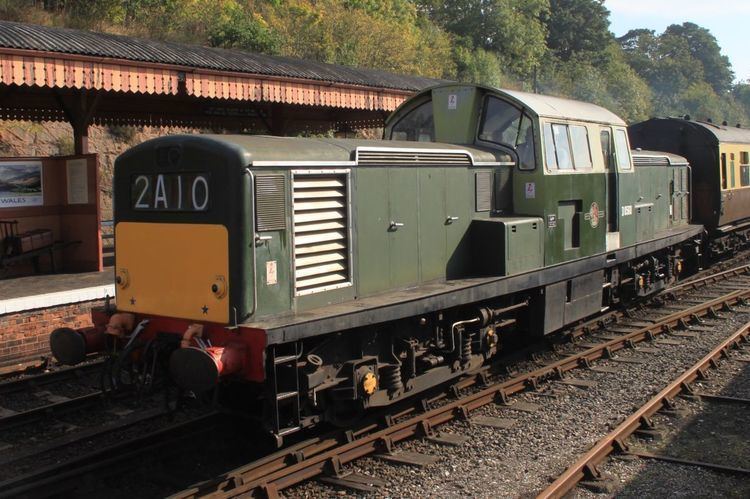Power type Diesel-electric Total produced 117 UIC class Bo'Bo' | Build date 1962–1965 | |
 | ||
Builder Clayton Equipment Company & Beyer, Peacock & Co. | ||
The British Rail Class 17 (also known as the Clayton Type 1) was a class of 117 Bo-Bo diesel-electric locomotives built 1962–1965 by Clayton Equipment Company and their sub-contractor Beyer, Peacock & Co., for British Railways (BR).
Contents
Overview
Following problems with the single-cabbed pilot scheme Type 1 locomotives, the Class 17s were designed with a centre cab and low bonnets to maximise visibility for the driver. The low engine covers required the use of two Paxman 6ZHXL six-cylinder horizontal engines and these gave unreliable performance even after extensive modifications. The class proved to be one of the least successful of the Type 1s. Withdrawals took place from the late 1960s to 1971, some locomotives having a working life of less than five years. Several were sold to industrial users, but only one has been preserved.
Earlier designs
The Type 1 was the lowest power classification for BR mainline diesels. Under BR's 'pilot scheme', three different designs of Type 1 locomotive had been produced. Two of these (Classes 15 and 16 under the TOPS classification system) were of a 'road-switcher' type layout based on the 10800 prototype, with a single off-centre cab, from which forward visibility for the crew was poor in both directions of travel, while the third (Class 20) had its cab at one end, giving good visibility in that direction only. After experience with these, and although Class 20 was a technical success, BR decided that it wanted a single-cab Type 1 locomotive with good forward visibility in both directions.
The Class 17
The result was the Class 17, fitted with a centre cab and low engine covers. These requirements meant that instead of having a single large engine, it was necessary to use two smaller six-cylinder horizontal engines, one on either side of the cab.
Most were powered by two Paxman 6ZHXL engines of 450 hp (340 kW) each, an engine originally intended for diesel railcars, but not adopted. The last two of the Clayton-built batch, D8586-D8587, each had a pair of Rolls Royce Type D 450 hp (340 kW) engines.
British Railways ordered 117 off the drawing board, and announced to the railway press that these locos were to be the new Type 1 standard. The designer, the Clayton Equipment Company of Hatton, Derbyshire completed locomotives D8500-D8587 between September 1962 and February 1965, while sub-contractor Beyer, Peacock and Company of Manchester delivered D8588-D8616 between March 1964 and April 1965.
The Clayton examples had 'red diamond' control equipment while the Beyer Peacock batch had the standard 'blue star' type.
Operations
The Clayton examples were delivered to the Scottish Region depots at Polmadie and Haymarket, although some later migrated to Kingmoor on the London Midland Region. The Beyer Peacock locomotives were new to the North Eastern Region at Thornaby (4) and Gateshead (12) and to the Eastern Region at Tinsley (12) and Barrow Hill (1). In September 1963 numbers D8501 and D8536 moved to the Tyne Dock area where they were tested in multiple on Consett iron ore trains. They proved far too underpowered for this work, and so were moved to Ardsley shed a few months later where they undertook a variety of freight work both individually and in multiple. Subsequently all of the locomotives allocated to the Eastern Region were transferred to Haymarket where they were employed on freight traffic in southern Scotland and northern England.
Problems
This design was arguably the least successful diesel locomotive ever employed on British Railways after the ill-fated Co-Bo. The twin Paxman engines were unreliable, being prone to camshaft and cylinder head problems amongst others; overall availability was around 60%, even after extensive modifications. Forward visibility, which had dictated the whole design of the type, was not as good as had been hoped, the long noses meaning that the crew could not see the area immediately in front of the locomotive. Although the Rolls Royce and Crompton Parkinson engined examples had better reliability, no further examples were ordered and BR decided to dispose of the type, replacing them with an order for 100 of the already proven Class 20 locomotives.
Withdrawal and Preservation
Withdrawals began in July 1968 and the final locomotives were withdrawn in December 1971. The Class 17s had by far the shortest lives of any significant BR diesel-electric locomotive design, with many examples having a working life of less than five years. Most had been scrapped by the end of 1975, but at this time the possibility of converting 9 of the remaining locos to battery operation was mooted. This came to nothing, and although D8521 and D8598 enjoyed a brief reprieve by being sent to Derby Research Centre; one as mobile power plant and the other on test trains, both were withdrawn in 1978 and subsequently scrapped.
After withdrawal in 1971, D8568 went on to see industrial use at Hemelite, Hemel Hempstead and at Ribblesdale Cement, Clitheroe, and was then secured for preservation. It is now (2016) at the Chinnor and Princes Risborough Railway, Oxfordshire.
In fiction
In the Thomas the Tank Engine and Friends TV Series, a character based on this class appears by the name of Derek, with the problems inherent to the class incorporated into the character and his sole episode.
Models
Danish manufacturer Heljan launched a 00 gauge ready-to-run model of the Class 17 at the 2006 Warley National Model Railway Exhibition which went on sale after some production delays in early 2009. Aside from small runs by TechCad, and in kit form by DC Kits and others, this was the first time the class had been produced as a ready-to-run model.
